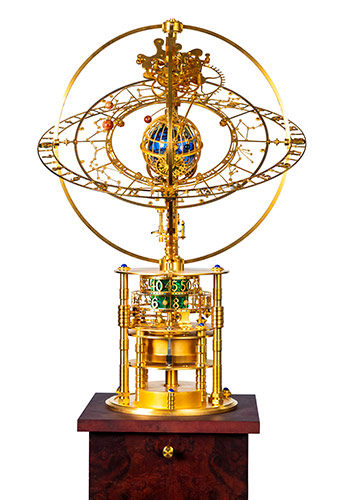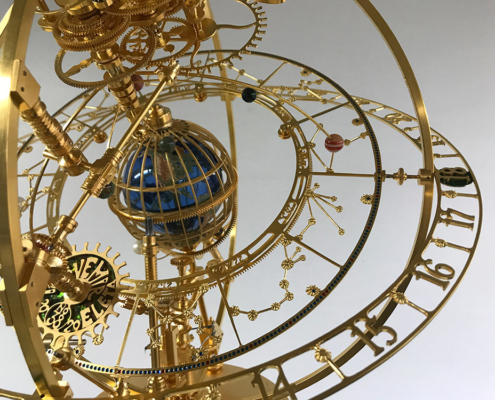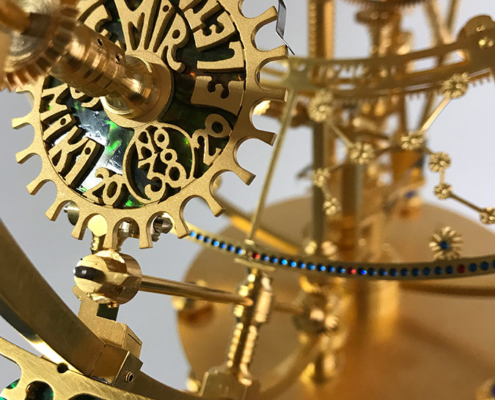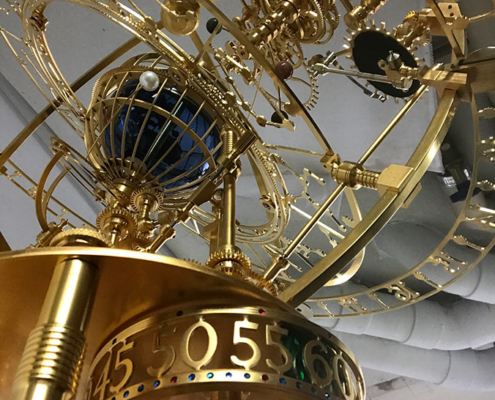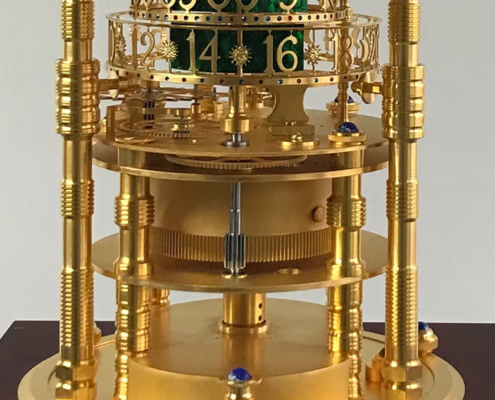Svemir
Svemir (Universe), Miki Eleta 2020
“Svemir” combines two astronomical models in one clock. Geocentrism places the earth in the center, orbited by the sun, the moon and the rest of the planets. During the 16th century, the Copernican Revolution replaced this concept by heliocentrism, in which all planets and their moons revolve around the sun.
Inspired by the construction of an armillary sphere, the geocentric model in “Svemir” consists of a globe surrounded by rings. In a cage of meridians, the earth rotates around its axis in 24 hours. The earth equator lies on the same level as the skeletonized static disk with a division into 24 parts. Positioned as the celestial equator, it shows the hour and the world time, as the division runs concentrically to the earth’s meridians.
The ecliptic ring represents the assumed path of the sun in the geocentric model as it appears from the earth. The seasons, the months, the zodiac signs with their start and end dates, the highest and lowest positions of the sun as well as equinoxes can be read on its 12 segments.
The sun is represented as a white ball that moves under the current date by 1/365 per day along the ecliptic ring.
The moon moves by jumping one division every day. It shows the moon phase, solar eclipses and tides (correction every 128 years).
The heliocentric model diagonally above the globe consists of its own sun and six planets. All six planets are mounted on a common axis inclined by 23.5 degrees relative to the axis of the earth. They revolve around the fixed sun visible below. According to Kepler’s laws, the sun is slightly offset to the axis of the planets. The model displays the orbits of Mercury (period of revolution: 88 days), Venus (225 days), Earth (365 days), Mars (687 days = 1.8 years), Jupiter (4329 days = 11.86 years) and Saturn (10751 Days = 29, 45 years).
The clock shows hours and minutes and provides the energy for all of the above functions. A manual demonstration of the planetary motion in the heliocentric model is possible using a separate crank. The mechanism features a memory function, which can be used to move the model back to the correct position after a manual demonstration.
Construction time: April to December 2020
Technical specifications
Total height: 1850 mm
Wooden base (walnut): H: 1250mm, W: 250 mm, D: 250 mm
Foot: W: 330 mm, D: 330 mm
Weight drive
Huygens endless-rope winding-mechanism (winding without interruption of the clock)
Power reserve: 6 days
Swiss lever escapement
Oscillation duration: 1.73 sec
Displays: minute, hour, world time, month, season, signs of the zodiac with start and end date, equinoxes, solstices, moon phases, solar eclipses, tides, geocentric model, heliocentric model.
Materials: gold plated brass, chrome plated brass, steel, lapis lazuli, mother-of-pearl, gemstones
(planets).
Overall view
Planetary motion

